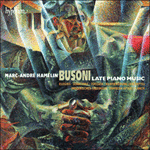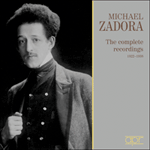Busoni was a big believer in the importance of transcription. As with the
Chaconne, the
Kammer-Fantasie über Carmen uses ideas present in repertoire he admired—in this case, Bizet’s opera. Bizet’s melodies are clay that, in Busoni’s hands, is sculpted with breathtaking creativity. This re-imagining forms the basis of Busoni’s sixth sonatina, completed in 1920. It was premiered by the composer in the same year at Wigmore Hall. The work takes its thematic material from the opening chorus of the fourth act, Don José’s ‘Flower song’ in Act II, the Act I ‘Habanera’ (in its minor and major forms), and the prelude to Act I. The
Kammer-Fantasie über Carmen bears all the Busoni hallmarks: it begins with a twinkly melody that is quickly re-invented, appearing in all sorts of guises up and down the keyboard before launching into a dizzyingly complex version of the beloved ‘Habanera’. The kaleidoscope eventually slows to reveal the melody in a recognizable state.
from notes by Claire Jackson © 2021
Busoni croyait beaucoup en l’importance de la transcription. Comme dans le cas de la
Chaconne, la
Kammer-Fantasie über Carmen utilise des idées présentes dans le répertoire qu’il admirait—ici, l’opéra de Bizet. Les mélodies de Bizet sont de l’argile sculptée entre les mains de Busoni avec une créativité stupéfiante. Cette réinterprétation forme la base de la sixième sonatine de Busoni, achevée en 1920. Elle fut créée par le compositeur la même année au Wigmore Hall. L’œuvre tire son matériel thématique du chœur initial du quatrième acte, de «La fleur que tu m’avais jetée» à l’acte II, de la «Habanera» de l’acte I (dans ses formes mineure et majeure) et du prélude de l’acte I. La
Kammer-Fantasie über Carmen présente toutes les caractéristiques de Busoni: elle commence par une mélodie scintillante vite réinventée, qui prend toute sorte de formes du haut en bas du clavier avant de se lancer dans une version d’une complexité vertigineuse de la bien-aimée «Habanera». Le kaléidoscope finit par ralentir pour révéler la mélodie dans un état reconnaissable.
extrait des notes rédigées par Claire Jackson © 2021
Français: Marie-Stella Pâris
Wie wir bereits gehört haben, war Busoni fest von der Bedeutung der Transkription überzeugt. Ebenso wie in der
Chaconne werden in der
Kammer-Fantasie über Carmen Motive aus einem Werk verarbeitet, welches er bewunderte—in diesem Falle Bizets Oper. Die Melodien Bizets werden hier, in Busonis Händen, mit atemberaubender Kreativität umgeformt und umgestaltet. Diese Nachschöpfung bildet die Basis der sechsten Sonatine Busonis, die er 1920 fertigstellte. Sie wurde noch im selben Jahr von dem Komponisten in der Londoner Wigmore Hall erstmals öffentlich aufgeführt. Das thematische Material des Werks stammt aus dem Eingangschor des vierten Akts, Don Josés „Blumenlied“ aus dem zweiten Akt, der „Habanera“ aus dem ersten Akt (sowohl in der Moll- als auch der Durversion) und dem Vorspiel zum ersten Akt. Die
Kammer-Fantasie über Carmen enthält alle typischen Kennzeichen Busonis: sie beginnt mit einer funkelnden Melodie, die rasch umgearbeitet wird und dann in allen möglichen Gestalten die Klaviatur hinauf- und heruntereilt, bevor sie in eine schwindelerregend komplexe Version der beliebten „Habanera“ übergeht. Schließlich verlangsamt sich das Kaleidoskop und die Melodie tritt in erkennbarer Form hervor.
aus dem Begleittext von Claire Jackson © 2021
Deutsch: Viola Scheffel


 Busoni: Late Piano Music
Busoni: Late Piano Music Michael Zadora - The complete recordings
Michael Zadora - The complete recordings Vida breve
Vida breve
